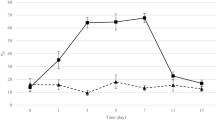Abstract
The degree of binding of ampicillin, cephradine, co-trimoxazole, gentamicin, nalidixic acid, neomycin, polymyxin B and tobramycin by faecal substance as well as the influence of these antibiotics on human intestinal obligate anaerobes was investigated. In contrast to ampicillin, cephradine, co-trimoxazole and nalidixic acid, the nonabsorbable antibiotics polymyxin B and neomycin were bound to a considerable degree by human faeces. The binding of tobramycin and gentamicin to the solid part of faeces was less effective. The inhibitory effect of co-trimoxazole, gentamicin, nalidixic acid, neomycin, polymyxin B and to-bramycin on the human obligate anaerobes was weak as compared with ampicillin and cephradine.
Drugs which effectively eliminate Enterobacteriaceae from the gastrointestinal tract and which have a moderate effect on obligate anaerobes, like polymyxin B, are particularly suitable for selective decontamination of the gastrointestinal tract. The strong inactivating binding of aminoglycosides and polymyxin B to faeces accounts for the relatively high oral dose needed for a suitable faecal concentration.
Similar content being viewed by others
References
Appelbaum, P. C. and Chatterton, S. A. 1978. Susceptibility of anaerobic bacteria to ten antimicrobial agents — Antimicrob. Agents Chemother. 14: 374–376.
Bennet, J. V., Brodie, J. L., Benner, E. J. and Kirby, W. M. M. 1966. Simplified accurate method for antibiotic assay of clinical specimens. — Appl. Microbiol. 14: 170–177.
De Vries-Hospers, H. G., Sleijfer, D. T., Mulder, N. H., Van der Waaij, D., Nieweg, H. O. and Van Saene, H. K. F. 1981. Bacteriological aspects of selective decontamination of the digestive tract as a method of infection prevention in granulocytopenic patients. — Antimicrob. Agents Chemother. 19: 813–820.
E.O.R.T.C. Gnotobiotic Project Group. 1982. A prospective cooperative study of antimicrobial decontamination in granulocytopenic patients. Comparison of two different methods. — Infection 10: 131–138.
Gotoff, S. P. and Lepper, M. H. 1965. Treatment of Salmonella carriers with colistin sulfate. —Amer. J. Med. Sci.. 249: 399–403.
Guiot, H. F. L., Van der Meer, J. W. M. and Van Furth, R. 1981. Selective antimicrobial modulation of human microflora: infection prevention in patients with decreased host defence mechanisms by selective elimination of potentially pathogenic bacteria. — J. Infect. Dis. 143: 644–653.
Hazenberg, M. P., Bakker, M. and Verschoor-Burggraaf, A. 1981. Effects of the human intestinal flora on germ-free mice. — J. Appl. Bact. 50: 95–106.
Hazenberg, M. P., Van de Boom, M., Bakker, M. and Van de Merwe, J. P. 1987. Effect of antibiotics on the human intestinal flora in mice. Antonie van Leeuwenhoek 49: 97–109.
Stephen, A. M. and Cummings, J. H. 1980. The microbial contribution to human faecal mass. — J. Med. Microbiol. 13: 45–56.
Sutter, V. L. and Finegold, S. M. 1976. Susceptibility of anaerobic bacteria to 23 antimicrobial agents. — Antimicrob. Agents Chemother. 10: 736–752.
Van der Waaij, D., Berghuis-De Vries, J. M. and Lekkerkerk-Van der Wees, J. E. C. 1971. Colonization resistance of the digestive tract in conventional and antibiotic-treated mice. — J. Hyg. Camb. 69: 405–411.
Author information
Authors and Affiliations
Rights and permissions
About this article
Cite this article
Hazenberg, M.P., van de Boom, M., Bakker, M. et al. Binding to faeces and influence on human anaerobes of antimicrobial agents used for selective decontamination. Antonie van Leeuwenhoek 49, 111–117 (1983). https://doi.org/10.1007/BF00393668
Received:
Issue Date:
DOI: https://doi.org/10.1007/BF00393668




